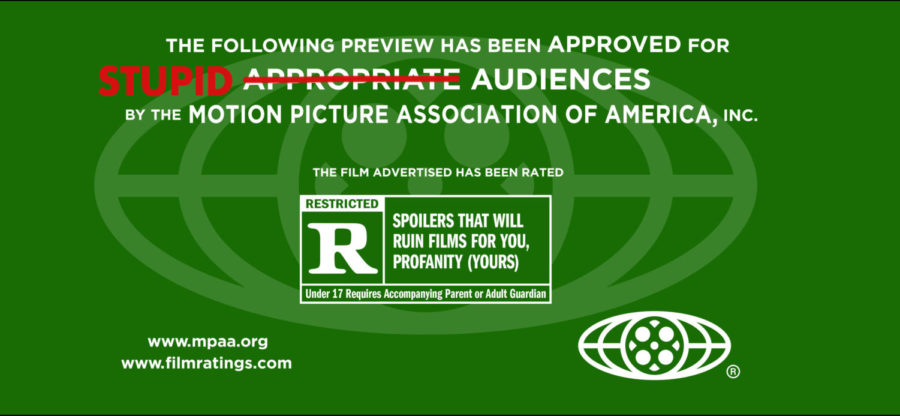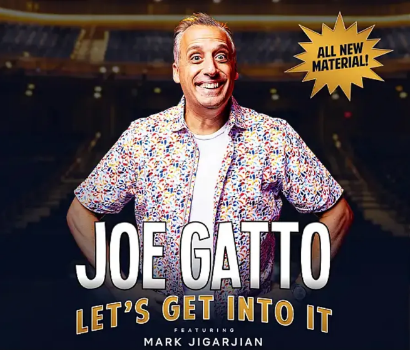Opinion: Studios think we’re too stupid to see a movie without them spoiling the plot
Why I refuse to watch movie trailers.
This image is the property of the Motion Picture Association (https://www.motionpictures.org) and is used here in parody for the purpose of critique.
May 5, 2023
Trailers can be the most enjoyable part of going to the theatre. They’re exciting, new and short enough to keep a hold on our ever-dwindling attention spans. If done correctly, trailers set the tone for a film and generate audience interest. So why is it rare to see a solid trailer that doesn’t lay out every plot point beat by beat? I cannot count the number of times I’ve skipped seeing a new movie because I basically did in 2 minutes.
Consider “The Last House on the Left” (2009). Exactly 30 seconds into the trailer, what is revealed? A teenage girl, Mari, is vacationing with her parents at their lake house, or “The only house for miles, Dad.” After borrowing her parents’ car to meet a friend, Paige, the two girls meet Justin, a nervous-looking peer. While hanging out with their anxious new friend in what looks like a motel room, they are interrupted by an older group of delinquent 20-something year-olds.
Then, 37 seconds in, Justin receives a swift gut punch for bringing Mari and Paige to wherever he and the group are staying. This is followed by shots of a newspaper displaying the headline, “MURDEROUS RAMPAGE.” The group’s assumed ringleader declares, “I’m sorry ladies, we just can’t risk it.” After the shots of Mari and Paige being brutalized in various ways are displayed, the group is stranded and looking for shelter. Of course, they settle on the only house for miles. The murderers plead their case of car trouble, unknowingly, to their victim’s parents. Citing the lack of phone reception or car, the parents offer refuge in the guest house while Justin looks despondently at refrigerator pictures of Mari.
At this point, you would have viewed 1 minute and 16 seconds of the trailer. Fearing the audience can’t infer more of the plot, a bloody Mari climbs out of a stormy lake and manages to make it to her back porch. Using a rocking chair, she rhythmically taps the back of the house to get her parent’s attention; if there was any doubt the audience would grasp this, the editor made sure to include the line by Mari’s father, “Did you hear that?” followed by a horrified, “MARI!” upon discovery. To really nail home her battered state, her father reveals, “She’s been shot.”
We are now at the 1 minute and 30 second mark of the trailer. Her father asks Mari who did this to her, and we can assume she told them as her mother desperately asks, “What are we gonna do? We don’t have a car; the phones are dead and they’re still here!” Whoever stitched together this trailer wanted us to know every obstacle this family is facing. They also wanted us to know they are ready to do anything, by means of Mari’s father assuring his wife, “This means we need to be ready to do anything.”
A text card reading, “IF SOMEONE HURT SOMEONE YOU LOVE” flashes between scenes implying Mari’s sexual assault and revenge against the vicious home invaders. The following text card, “HOW FAR WOULD YOU GO TO HURT THEM BACK” is not concluded with a question mark, but rather a line from Mari’s dad, “I wanna hear you beg for your life.” Cut to, THE FINAL SCENE OF THE MOVIE to tie up this 2-minute 29-second trailer. I will not elaborate on the final scene, because it’s the best part of the whole movie and I’m upset that it’s in the trailer.
From the information above, you can assume a lot about this movie, and you’d be right. Here’s a list:
- The lakehouse is in an isolated, wooded area.
- The gang Justin is with are fugitives/murderers.
- Mari and Paige are beaten and sexually assaulted.
- Paige for sure dies
- Mari is shot and left for dead but manages to survive.
- The gang unknowingly seeks shelter from the storm with the parents.
- Justin sees pictures of Mari on the fridge and doesn’t tell the gang.
- There is no car or working phone (closed-circle trope).
- Justin’s guilt will result in a confession to Mari’s parents/turning on the gang.
- Mari is rescued by her parents.
- Parents methodically plan/carryout revenge.
- Every member of the gang dies in a horrible way.
- The ringleader dies in the worst way.
If you can ignore the entire plot unfolding in the trailer, this was a great movie. You couldn’t ask for a better cast. Sara Paxton, Tony Goldwyn, Monica Potter, Riki Lindhome and Aaron Paul gave better performances than the world deserved in 2009. Some could argue that this movie is a remake, so spoilers are already out there. I rebuke this. Remake status aside, this film has several differences setting it apart from Wes Craven’s original. Existing source material does not justify showing every single plot point, ESPECIALLY THE END SCENE. Unsurprisingly, the audience reception was poor.
Why were movie-goers spoon-fed the entire plot before an official release date? Who has the final say on trailer editing? Most large studios source trailers through a third-party trailer production company. That being said, “The Last House on the Left” (2009) was released by Universal Studios. Trailer production companies will usually make multiple cuts of a trailer and test screen it among different demographics. In a 2018 article by The Ringer, Buddha Jones editor, Bill Neil, explains, “To get butts in seats, you might have to show a little bit more. People want to know what they’re buying. They don’t want to just go in blindly. If you’re sold on the movie already, you don’t need to watch the trailer.”
Studio execs have a reputation for prioritizing sales over longevity in art. The focus group numbers don’t lie, but at what cost? While people may feel more comfortable buying tickets when possessing more information on the plot, this does not inherently equal long-term benefits. But hey, studio execs got a bunch of asses in seats at least once! Who cares about the director’s vision or the actor’s ability to perform? Attempting to utilize artists in the vein of mass appeal is futile and absurd. Have you ever met a person? If they know what they want, they change their mind; if they don’t know what they want, they hate to be told. Artists communicate ideas and thoughts to evoke emotion from the consumer, then they decide what it means to them. Film will never have “mass appeal” because people form their own opinions, regardless of corporate appeasement.
“But Liv, doesn’t that kill your argument against trailers spoiling movies?” I am so glad you asked – NO. If someone goes to the theatre with certain expectations (garnered from the trailer), they will be more critical of the film if those expectations are unmet. What could have been a film recommendation to a friend is now vehement dissuasion. This person won’t see the sequel or any related properties, or buy merch. It’s just a bad movie they saw one time. As someone who considers themselves an avid theatre attendee, I do not want to be handled like a delicate wallet with legs. I do not want the defining factor of a film to be dollar value or how many people liked it. I do not need a preliminary plot summary; I am not a bagged goldfish floating in a new tank.
A movie that doesn’t octuple its budget via ticket sales, while maintaining the director’s authentic message, is preferable to endless studio meddling in service of inflated numbers. This soapbox is not to say any studio involvement is bad. If studios want to produce movies, the people they hire need creative control to direct and set the tone for their art. Humanity will just have to shoulder the burden of knowing some CEO won’t be able to afford that triceratops skull they’ve been eyeing as a new incense burner.












